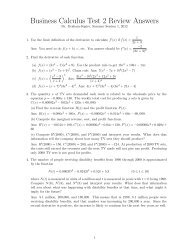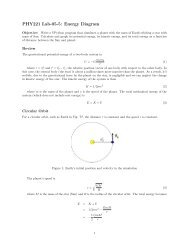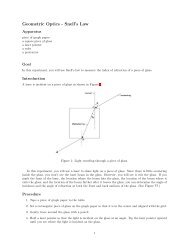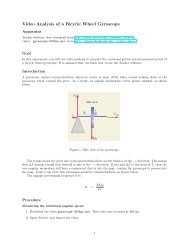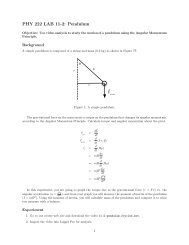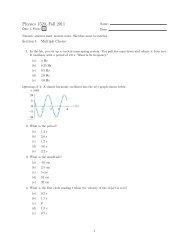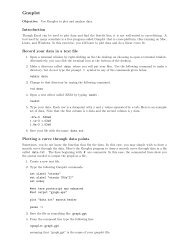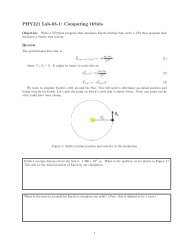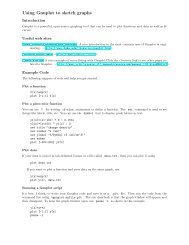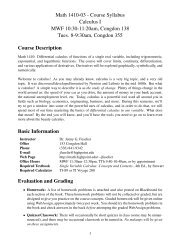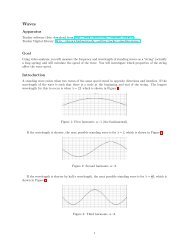The Hubble Redshift Distance Relation
The Hubble Redshift Distance Relation
The Hubble Redshift Distance Relation
Create successful ePaper yourself
Turn your PDF publications into a flip-book with our unique Google optimized e-Paper software.
<strong>The</strong> <strong>Hubble</strong> <strong>Redshift</strong> <strong>Distance</strong> <strong>Relation</strong>Student ManualA Manual to Accompany Software forthe Introductory Astronomy Lab ExerciseDocument SM 3: Version 1Department of PhysicsGettysburg CollegeGettysburg, PA 17325Telephone: (717) 337-6028email: clea@gettysburg.eduContemporary LaboratoryExperiences in Astronomy
Version 1.0GoalYou should be able to find the relationship between the redshift in spectra of distant galaxiesand the rate of the expansion of the universe.ObjectivesIf you learn to.........Use a simulated spectrometer to acquire spectra and apparent magnitudes.Determine distances using apparent and absolute magnitudes.Measure Doppler shifted H & K lines to determine velocities.You should be able to.......Calculate the rate of expansion of the universe.Calculate the age of the universe.PAGE 3
Student ManualEquipment and MaterialsComputer running CLEA <strong>Hubble</strong> <strong>Redshift</strong> <strong>Distance</strong> <strong>Relation</strong> laboratory exercise. Pencil, ruler, graph paper, calculator.Introduction<strong>The</strong> late biologist J.B.S.Haldane once wrote: “<strong>The</strong> universe is not only queerer than we suppose, but queerer than we cansuppose.” One of the queerest things about the universe is that virtually all the galaxies in it (with the exception of a fewnearby ones) are moving away from the Milky Way. This curious fact was first discovered in the early 20th century byastronomer Vesto Slipher, who noted that absorption lines in the spectra of most spiral galaxies had longer wavelengths(were “redder”) than those observed from stationary objects. Assuming that the redshift was caused by the Doppler shift,Slipher concluded that the red-shifted galaxies were all moving away from us.In the 1920’s, Edwin <strong>Hubble</strong> measured the distances of the galaxies for the first time, and when he plotted these distancesagainst the velocities for each galaxy he noted something even queerer: <strong>The</strong> further a galaxy was from the Milky Way, thefaster it was moving away. Was there something special about our place in the universe that made us a center of cosmicrepulsion?Astrophysicists readily interpreted <strong>Hubble</strong>’s relation as evidence of a universal expansion. <strong>The</strong> distance between allgalaxies in the universe was getting bigger with time, like the distance between raisins in a rising loaf of bread. Anobserver on ANY galaxy, not just our own, would see all the other galaxies traveling away, with the furthest galaxiestravelling the fastest.This was a remarkable discovery. <strong>The</strong> expansion is believed today to be a result of a “Big Bang” which occurredbetween 10 and 20 billion years ago, a date which we can calculate by making measurements like those of <strong>Hubble</strong>. <strong>The</strong>rate of expansion of the universe tellsus how long it has been expanding.We determine the rate by plotting thevelocities of galaxies against theirdistances, and determining the slopeof the graph, a number called the<strong>Hubble</strong> Parameter, H o, which tells ushow fast a galaxy at a given distanceis receding from us. So <strong>Hubble</strong>’sdiscovery of the correlation betweenvelocity and distance is fundamentalin reckoning the history of theuniverse.Figure 1:<strong>Hubble</strong>’s ConstantUsing modern techniques of digitalastronomy, we will repeat <strong>Hubble</strong>’sexperiment. <strong>The</strong> technique we willuse is fundamental to cosmologicalresearch these days. Even though<strong>Hubble</strong>’s first measurements weremade three-quarters of a century ago,we have still only measured the velocities and distances of a small fraction of the galaxies we can see, and so we haveonly small amount of data on whether the rate of expansion is the same in all places and in all directions in the universe.<strong>The</strong> redshift distance relation thus continues to help us map the universe in space and time.PAGE 4
Version 1.0Technique<strong>The</strong> software for the CLEA <strong>Hubble</strong> <strong>Redshift</strong> <strong>Distance</strong> <strong>Relation</strong> laboratory exercise puts you in control of a largeoptical telescope equipped with a TV camera and an electronic spectrometer. Using this equipment, you will determinethe distance and velocity of several galaxies located in selected clusters around the sky. From these data you will plot agraph of velocity (the y-axis) versus distance (the x-axis).How does the equipment work? <strong>The</strong> TV camera attached to the telescope allows you to see the galaxies, and “steer” thetelescope so that light from a galaxy is focused into the slit of the spectro-meter. You can then turn on the spectrometer,which will begin to collect photons from the galaxy. <strong>The</strong> screen will show the spectrum—a plot of the intensity of lightcollected versus wavelength. When a sufficient number of photons are collected, you will be able to see distinct spectrallines from the galaxy (the H and K lines of calcium), and you will measure their wavelength using the computer cursor.<strong>The</strong> wavelengths will be longer than the wavelengths of the H and K labs measured from a non-moving object (397.0 and393.3 nanometers), because the galaxy is moving away. <strong>The</strong> spectrometer also measures the apparent magnitude of thegalaxy from the rate at which it receives photons from the galaxy. So for each galaxy you will have recorded the wavelengthsof the H and K lines and the apparent magnitude.From the data collected above, you can calculate both the speed of the galaxy from the Doppler-shift formula, and thedistance of the galaxy by comparing its known absolute magnitude (assumed to be (-22) for a typical galaxy) to itsapparent magnitude. <strong>The</strong> result is a velocity (in km/sec) and a distance (in megaparsecs, Mpc) for each galaxy. <strong>The</strong>galaxy clusters you will observe have been chosen to be at different distances from the Milky Way, giving you a suitablerange to see the straight line relationship <strong>Hubble</strong> first determined. <strong>The</strong> slope of the straight line will give you the value ofH o, the <strong>Hubble</strong> Parameter, which is a measure of the rate of expansion of the universe. Once you have H o, you can takeits reciprocal to find the age of the universe.<strong>The</strong> details of the measurements and calculations are described in the following sections.Using the <strong>Hubble</strong> <strong>Redshift</strong> ProgramWelcome to the observatory! We will simulate an evening’s observation during which we will collect data and drawconclusions on the rate of expansion of the universe. We will gain a proficiency in using the telescope to collect data byworking together on the first object. Collecting data for the other four objects will be left to you to complete theevening’s observing session. <strong>The</strong>n you will analyze the data, draw your conclusions, and use the information to predictthe age of the universe.Let’s begin.1. Open the <strong>Hubble</strong> <strong>Redshift</strong> program by double clicking on the <strong>Hubble</strong> <strong>Redshift</strong> Icon (pink). Click on Log in... inthe MENU BAR and enter student names and the lab table number. Click OK when ready.2. <strong>The</strong> title screen of exercise appears. In the MENU BAR, the only available (bold-faced) choices are to start or toquit, click on Start.<strong>The</strong> <strong>Hubble</strong> <strong>Redshift</strong> <strong>Distance</strong> <strong>Relation</strong> program simulates the operation of a computer-controlled spectrometerattached to a telescope at a large mountain-top observatory. It is realistic in appearance, and is designed to give youa good feeling for how astronomers collect and analyze data for research.<strong>The</strong> screen shows the control panel and view window as found in the “warm room” at the observatory. Notice thatthe dome is closed and tracking status is off.PAGE 5
Student Manual3. To begin our evening’s work, first open the dome by clicking on the dome button.<strong>The</strong> dome opens and the view we see is from the finder scope. <strong>The</strong> finder scope is mounted on the side of the maintelescope and points in the same direction. Because the field of view of the finder scope is much larger than the fieldof view of the main instrument, it is used to locate the objects we want to measure. <strong>The</strong> field of view is displayed onscreenby a CCD camera attached on the finder scope. (Note that it is not necessary for astronomers to view objectsthrough an eyepiece.) Locate the Monitor button on the control panel and note its status, i.e. finder scope. Alsonote that the stars are drifting in the view window. This is due to the rotation of the earth and is very noticeableunder high magnification of the finder telescope. It is even more noticeable in the main instrument which has even ahigher magnification. In order to have the telescope keep an object centered over the spectrometer opening (slit) tocollect data, we need to turn on the drive control motors on the telescope.4. We do this by clicking on the tracking button.<strong>The</strong> telescope will now track in sync with the stars. Before we can collect data we will need to do the following:(a) Select a field of view (one is currently selected).(b) Select an object to study (one from each field of view).5. To see the fields of study for tonight’s observing session.Click once on the change field item in the MENU BAR at the top of the control panel.<strong>The</strong> items you see are the fields that contain the objects we have selected to study tonight. An astronomer wouldhave selected these fields in advance of going to the telescope by:(a) Selecting the objects that will be well placed for observing during the time we will be at the telescope.(b) Looking up the RA and DEC of each object field in a catalog such as Uranometria 2000, Norton’s Atlas, etc.This list in the change field menu item contains 5 fields for study tonight. You will need to select one galaxy fromeach field of view and collect data with the spectrometer (a total of 5 galaxies).To see how the telescope works, change the field of view to Ursa Major II at RA 11 hour 0 minutes and Dec. 56degrees 48 min.Notice the telescope “slews” (moves rapidly) to the RA and DEC coordinates we have selected. <strong>The</strong> view windowwill show a portion of the sky that was electronically captured by the charge coupled device (CCD) camera attachedto the telescope.<strong>The</strong> view window has two magnifications (see Figure 2 on next page):Finder View is the view through the finder scope that gives a wide field of view and has a cross hair and outline ofthe instrument field of view.Spectrometer View is the view from the main telescope with red lines that show the position of the slit of thespectrometer.PAGE 6
Version 1.0Figure 2Field of View from the Finder ScopeAs in any image of the night sky, stars and galaxies are visible in the view window. It is easy to recognize brightgalaxies in this lab simulation, since the shapes of the brighter galaxies are clearly different from the dot-like imagesof stars. But faint, distant galaxies can look similar to like stars, since we can’t see their shape.6. Now change fields by clicking on Ursa Major I in the lists of selected galaxies to highlight the field. <strong>The</strong>n click theOK button.7. Locate the Monitor button in the lower left hand portion of the screen. Click on this button to change the view fromthe Finder Scope to the Spectrometer. Using the Spectrometer view, carefully position the slit directly over theobject you intend to use to collect data—any of the galaxies will be fine. Do this by “slewing”, or moving, thetelescope with the mouse and the N, S, E or W buttons. Place the arrow on the N button and click on the left mousebutton. To move continuously, press and hold down the left mouse button. Notice the red light comes on toindicate the telescope is “slewing” in that direction.As in real observatories, it takes a bit of practice to move the telescope to an object. You can adjust the speed or“slew rate” of the telescope by using the mouse to press the slew rate button. (1 is the slowest and 16 is the fastest).When you have positioned the galaxy accurately over the slit, click on the take reading button to the right of theview screen.<strong>The</strong> more light you get into your spectrometer, the stronger the signal it will detect, and the shorter twill be the timerequired to get a usable spectrum. Try to position the spectrometer slit on the brightest portion of the galaxy. If youposition it on the fainter parts of the galaxy, you are still able to obtain a good spectrum but the time required will bemuch longer. If you position the slit completely off the galaxy, you will just get a spectrum of the sky, which will bemostly random noise.We are about to collect data from the object. We will be looking at the spectrum from the galaxy in the slit of thespectrometer. <strong>The</strong> spectrum of the galaxy will exhibit the characteristic H & K calcium lines which would normallyappear at wavelengths 3968.847 Å and 3933.67 Å, respectively, if the galaxies were not moving. However, the H &K lines will be red shifted to longer wavelengths depending on how fast the galaxy is receding.Photons are collected one by one. We must collect a sufficient number of photons to allow identification of thewavelength. Since an incoming photon could be of any wavelength, we need to integrate for some time before wecan accurately measure the spectrum and draw conclusions.PAGE 7
Student Manual<strong>The</strong> more photons collected, the less the noise in the spectrum, making the absorption lines easier to pick out. Toinitiate the data collection, press start/resume count.8. To check the progress of the spectrum, click the stop count button. <strong>The</strong> computer will plot the spectrum with theavailable data. Clicking the stop count button also places the cursor in the measurement mode. Using the mouse,place the arrow anywhere on the spectrum, press and hold the left mouse button. Notice the arrow changes to a crosshair and the wavelength data appears in the lower right area of the window. As you hold the left mouse button, movethe mouse along the spectrum. You are able to measure the wavelength and intensity at the position of the mousepointer.Figure 3Spectrometer Reading WindowAlso notice other information that appears in the window:Object: the name of the object being studiedApparent magnitude: the visual magnitude of the objectPhoton count: the total number of photons collected so far, and the average number per pixelIntegration (seconds): the number of seconds it took to collect dataWavelength (angstroms): wavelength as read by the cursor in the measurement modeIntensity: relative intensity of light from the galaxy at the position marked by the cursor in the measurement modeSignal-to-noise Ratio: A measurement of the quality of the data taken to distinguish the H and K lines of calciumfrom the noise. Try to get a signal-to-noise ratio of 10 to 1. For faint galaxies, this may take some time.9. Click start/resume count from the menu bar in the Spectrometer Reading Window. Continue to collect photonsuntil a clear spectrum of the H & K lines of calcium is displayed. <strong>The</strong>se lines are approximately 40 Å apart. <strong>The</strong>yshould stand out from the noise. If not, continue to count photons. If you are not sure about the data, check with alab instructor to help you interpret the data.PAGE 8
Version 1.0Additional information is needed to complete the analysis of the information that is not displayed in the spectrometerreading window. <strong>The</strong>y are the following:(a) <strong>The</strong> absolute magnitude (M) for all galaxies in this experiment.(b) <strong>The</strong> laboratory wavelength of the K line of calcium is 3933.67 Å.(c) <strong>The</strong> laboratory wavelength of the H line of calcium is 3968.847 Å.10. Record the object, photon count, apparent magnitude, and the measured wavelength of the H & K lines of calcium onthe data sheet located at the end of this exercise. <strong>The</strong> H & K lines measured should be red shifted from the laboratoryvalues depending on the galaxies motion.11. To collect data for additional galaxies, press Return. Change the Monitor to display Finder, then follow steps 6through 10.MethodNow that we see how to use our instrument to collect data, we can use this information to determine for each galaxy, itsdistance and its velocity, using the following relationships:(A)M = m + 5 - 5*logDorlogD m - M +=55Note that we measure m and assume a value for M in order to calculate D (distance), where D is in parsecs.(B) vH = c ∗ ∆λ Ηandλ ΗvK = c ∗ ∆λ Κλ ΚNote that we measure l (wavelength) in order to calculate v.(C)∆λ H= Hmeasured− Hλ λ and ∆λ K= λ K measured− λ K1. Using the computer simulated telescope, measure and record on your data sheet the wavelengths of the calcium Hand K lines for one galaxy in each of the fields selected for the evenings observation. Also, be sure to record theobject name, apparent magnitude, and photon count. Round off numbers to two decimal places. Collect enoughphotons (usually around 40,000) to determine the wavelength of the line accurately.2. Use your measured magnitudes and the assumed absolute magnitude for each galaxy and derive the distance, (D), toeach galaxy using equation (A). Express your answer in both parsecs and megaparsecs in the appropriate places onyour data table. Note that equation (A) tells you how to find the log of the distance.PAGE 9
Student ManualTo find the distance, D, you must take the anti log, i.e.D =10 log DIf your calculator cannot calculate powers of 10, please ask to use your instructor’s calculator.3. Use your measured wavelengths given above to calculate the redshifts for each line, ∆λH and ∆λ K . Record each onyour data table.4. Use the Doppler shift formula, to determine the velocities as determined by both the H and K lines. <strong>The</strong>re is a placeon the data table for each of these figures:vH= c* ∆λλHHandvK= c* ∆λλKK5. Calculate and record the velocity of the galaxy. It is the average of the velocities determined from the H and K lines.6. Now plot a <strong>Hubble</strong> diagram by graphing the velocity of a galaxy in km/sec (y-axis) vs. the distance in megaparsecs(x-axis) on a sheet of graph paper. Draw a straight line through the origin that best fits all the data points. <strong>The</strong> slopeof the line is the <strong>Hubble</strong> Parameter (H). To calculate the slope of the line, measure a value of D and v from a pointnear the upper right end of the line you drew (do not use one of the points that you plotted, just use a data point).Determine H using the following equation:(D)H =v Dwhere H is the <strong>Hubble</strong> Parameter in km/sec/Mpcv is the velocity measured from your lineD is the distance measured from your linea) Record your value for the <strong>Hubble</strong> Parameter on your data table on the line called the Average Value of H.b) Mark the point you used on your graphc) Label the axis of your graph, and give it a meaningful title.Determining the Age of the Universe<strong>The</strong> <strong>Hubble</strong> Law, equation (D), can be used to determine the age of the universe. Using your average value of H,calculate the recessional velocity of a galaxy of a galaxy which is 800 Mpc away.Velocity of a galaxy 800 Mpc away:PAGE 10_______________________________km/sec
Version 1.0Verify your velocity by looking it up on your <strong>Hubble</strong> diagram. You now have two important pieces of information:1. How far away the galaxy is.2. How fast it is going away from us.You can visualize the process if you think about a trip in your car. If you tell a friend that you are 120 miles away fromyour starting point and that you traveled 60 miles per hour, your friend would know you had been traveling TWO hours.That is your trip started two hours ago. You know this from the relationship:<strong>Distance</strong> equals Rate ( or velocity ) * Timewhich we can write as(E)=D = R* Tor T D RThus, 2 hrs =120 mi60 mi / hrNow let’s determine when the universe “started its trip”. <strong>The</strong> distance is 800 Mpc, but first convert Mpc into km becausethe rate, or velocity, is in km/sec.800 Mpc = _____________________kmUse equation (E) to determine how many seconds ago the universe started:_____________________secs<strong>The</strong>re are about 3.15 x 10 7 seconds in one year. Convert your answer into years:_____________________years<strong>The</strong> age of the universe is ____________________ years.SHOW MATH HERE IN AN ORGANIZED FASHION.PAGE 11



